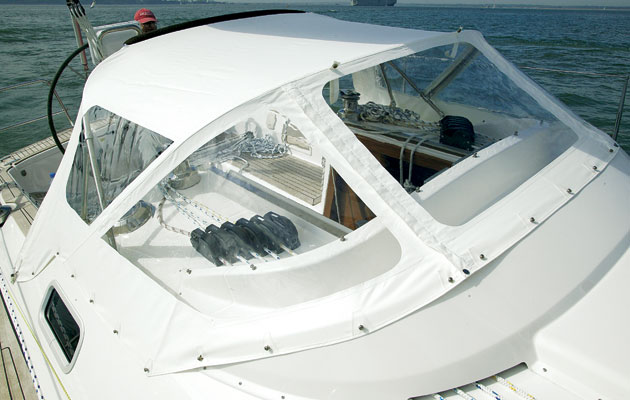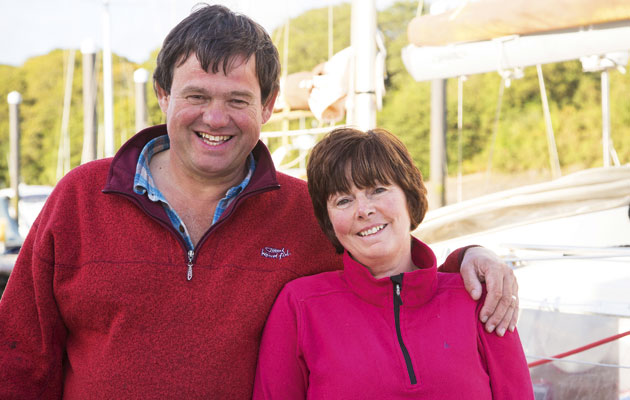Some of us are better suited than others to being hoisted aloft, as Jonty Pearce discovered, but good team work and thorough preparation make mast-head jobs go smoothly
The title of this blog should really be ‘The art of mast climbing’. However, being not insubstantially built, if I do venture up the mast I do rather remind onlookers of Mr Blobby on a stick. For this reason I avoid going up to such heights and instead send my dear wife – who likes such aerial activities – up aloft instead. Once there, whilst she has the confidence to work high up in the air, she unfortunately doesn’t possess my technical know-how and strength. Thus a certain degree of good team working and communication is necessary in order for us to do the varied tasks required as part of mast-top maintenance.
Typical work needing to be done includes adjustment of the Windex indicator (after seagull landings), replacement of the anchor or tricolour bulbs, rig checks, retrieving lost halyards, and the regular job of bringing down the wind sensor for bearing replacement. The last time Carol performed the latter task was some time after the yard had installed our new Raymarine system (using a crane). They had unexpectedly wrapped self amalgamating tape all round the thread which confused my advice to Carol. She tried to describe what she found to me, and it was only once I’d finally understood the situation that all was resolved with the aid of a Stanley knife and a pair of mole grips sent up in a bucket on a spare halyard.
There are various ways to ascend the mast. The classic method is undoubtedly by bosun’s chair, though bespoke climbers, mast ladders, mast steps and just being a mast monkey have their supporters. On a recent trip to Holland we were entertained by a Dutch lady who was winched up their catamaran’s mast by her husband. It was only after her return to the deck when she started to unwrap the cat’s cradle of rope from her waist and thighs that we realised that they evidently had no bosun’s chair on board; Heath Robinson techniques had been required. ‘Sooner her than us’ we all agreed. However their demonstration made us realise the degree of effort involved in using a winch to hoist somebody up the mast. If Carol tried to winch me in this fashion it would be a non-starter.
We choose to hoist a bespoke mast ladder up the sail track – it has its own sliders that sit securely in the slot to stop it migrating sideways or backwards whilst being climbed. It is attached at the boom before the hoisting halyard is cleated off tightly. The ladder uses the first halyard – a second is needed to tie a bowline to Carol’s harness or bosun’s chair, and we choose to use a third as a safety halyard. A fourth halyard would be useful to enable a bucket to be lifted and lowered, unless this were done freestyle with a length of loose line. Never use a snap shackle to attach a harness or bosun’s chair – they cannot be relied on, and a bowline is acknowledged to be far safer.
When aloft, stability, security, and the ability to work looking down are vital. I am never brave enough to go adequately high to be able to look down on the masthead equipment, but I’m glad to say Carol is. We are careful to tie lanyards to any tools used aloft lest they be dropped, and also to keep them in a hoisted bucket for ease of access. Being a suspicious cove, I ensure that the cabin roof and windows are well protected by bunk cushions so that if anything does fall it won’t end up making a dent in the deck or a hole in the glass.
Any task or job that needs to be done aloft needs careful planning and preparation. My last trip up the mast was whilst Aurial was dried out on a beach. I was able to attach the new removable inner forestay to a Selden fitting I had installed several years before. It had required both drilling and the cutting of a slot in the mast – not something I would fancy doing aloft, though it had been a doddle with the mast flat on a couple of bearers. I had also taken the opportunity to photograph all the mast top fittings; a pictorial catalogue that simplifies explanation of maintenance tasks to those going aloft.
Finally, consider the placement of the boat in preparation for an ascent. I prefer to be safely moored alongside a finger birth in a quiet marina or to be dried out securely on the beach. Those boats unable to take the ground will be denied that the latter stability, and those on a mooring would do well to choose a day when there is no swell – what may feel like a little ripple at deck height can be a swinging experience at the mast top. I take my hat off to hardy souls such as Ellen MacArthur who ascend the mast during ocean passages – and she was single-handed!
As for me, I’m best at deck height. I am not the correct shape for jogging, rock climbing, mast climbing, or ballet dancing. However, I can grind a winch in a very satisfactory way whilst assisting my dear wife who does all the dangerous bit. Long may our teamwork continue!
Jonty Pearce – Sprayhoods and cockpit covers
When it comes to cost, it all depends on the kind of sailing you do and your willingness to be…
Jonty Pearce: Going clubbing
Jonty Pearce pins his hopes on a sailing club and cruising with friends to ease him through the cold-turkey of…
Jonty Pearce: A seasonal consideration
With the end of the season approaching, Jonty Pearce considers whether to keep his boat ready for action, or to…
Jonty Pearce: A foul subject
We need to keep our hull clean, be don't want to be poisoning the water around our boats with antifouling,…







